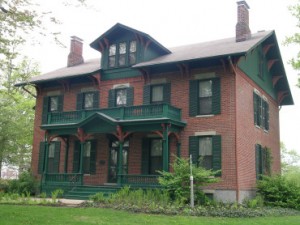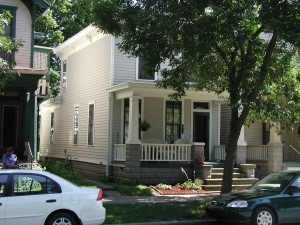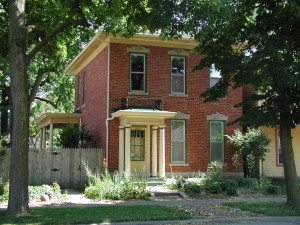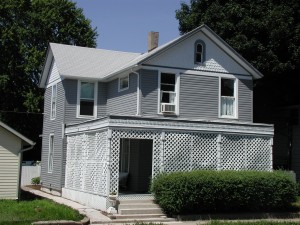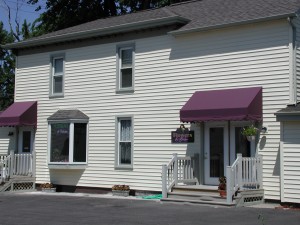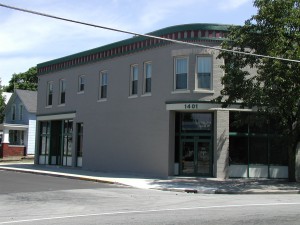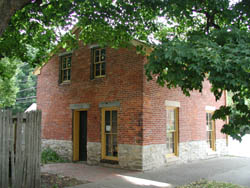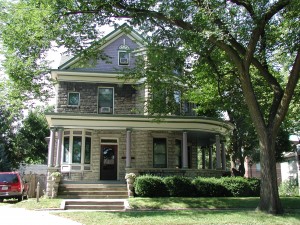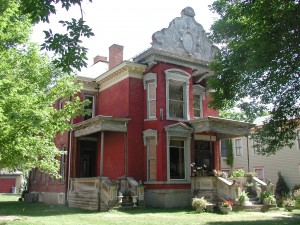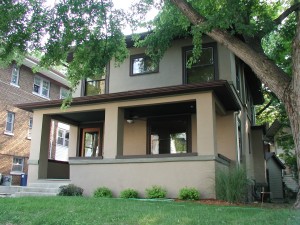[EasyGallery id=’hgt2002′]
Swinney Homestead
1424 West Jefferson Boulevard
Prominent local landowners Thomas and Lucy Swinney built their original Federal style home in 1844 using native Indiana walnut, poplar, and limestone. Their daughters remodeled the house in the Italianate style in 1886, adding the porch, the paired brackets, and the central wall dormer that simulates an Italian tower. The grounds became the Allen County Fairgrounds in 1874 and later became Swinney Park. Settlers, Inc. has leased the home since 1983 and led in its restoration.
Joe and Marla Baltes
1231 West Jefferson Boulevard
An example of a house style seen in America between 1840 and 1885, this Italianate house is simply detailed. The Italianate features include a simple hipped roof and beautifully carved brackets with pendant detail under the eaves of the roof. The dentil course along the cornice is a more Neo-classical detail. Where more elaborate Italianate houses have heavy crowns or hoods over the windows, this house exhibits simple crown molding. The porch is likely a later addition from the 1910s and 1920s.
The earliest recorded owner of the property, known as 323 West Jefferson Boulevard before 1902, was Frederick Ehlert who worked as a watchman-switchman-laborer with the Toledo, Wabash & Western Railway Company. The house was likely built after the lots were divided and sold in 1883.
Joe and Marla recently purchased the this lovely home after a whole house restoration.
John and Cindy Husar
1023 West Jefferson Boulevard (Garden only)
Originally known as 269 West Jefferson Boulevard before 1902, this house was built around 1867. It appears to have been owned by Peter Wirsche who worked as a watchman for the Pittsburgh, Fort Wayne, and Chicago Railroad.
The garden of this circa-1867 brick Italianate was nearly non-existent when the Husars purchased the longtime rental property and made it their home. The garden formerly contained roses, peonies, campanula, forsythia, and rose of Sharon. It is now home to over 150 varieties of perennials, annuals and herbs. The beds are bordered by brick and stone from former homes in the neighborhood and from Cindy’s family farm. Also featured in the garden are pieces of hand made pottery, sculpture and stone structures. Welcome to this eclectic and comfortable backyard garden.
Brenda Porter
612 Lavina Street
Built c.1895, this gabled-ell house displays some Queen Anne-influenced details such as the fish-scale shingling on the gable ends and turned porch posts. The lattice screening on the front porch is a recent addition.
The house at 612 Lavina Street, originally known as 38 Lavina Street, was likely built around 1895. George F. Warner lived here with his family until his death at the age of 67 in 1924. He had retired the previous year from the Pennsylvania Railroad Shops where he had worked as a machinist. George and his wife Julia had eight daughters.
Brenda purchased the home in spring of 1988, saving it from demolition by the City due to disrepair by former owners. In addition to completely restoring the interior with a fresh, airy feel, Brenda has transformed the back yard into a wonderful retreat. An entertainment deck, lily pond with fountain, vegetable and fruit gardens, shade garden and a latticed back porch are welcoming features.
Flowers & Barbara
613 West Brackenridge Street
Built c.1883, this Italianate house has experienced many remodelings over its lifetime.The only remaining original details include the ornate brackets with a pendant detail under the eaves and the modillions along the cornice line. Flowers & Barbara acquired the property very recently and converted it to commercial use. The inside has been completely remodeled for use as a flower shop. Its is owned and operated by Barbara Horn-May.
Solution Point
1401 Broadway
This Italianate commercial building known as the Spiegel Block, was built in 1905 by Gottfried Spiegel and his sons to house their grocery business. The recent restoration of the façade revived original details, such as the brick cornice with massive brick dentils and the flat arches over the windows, of the trapezoid-shaped brick building. The owner was given a 2001 ARCH award for commercial renovation.
ARCH, Inc.
918 Van Buren Street
Frederick & Mary Rockhill-Tyler House
This small brick structure was used as a garage beginning c.1910, however it is historically a hall-and-parlor house. It was built c.1840 and is among the oldest houses in the West Central Historic District. It was built by a member of the William Rockhill family. Architecturally, the house was influenced by the Greek Revival style, which was dominant from c.1830 to about 1855.
The hall-and-parlor house plan has its roots in the British Isles. It has only two roomson the first floor. The first is the multipurpose room or “hall” used for cooking, washing, and daily activities. The second room, the “parlor”, was used variously as a bedroom, guest room, reception room, or like the hall, had a combination of uses. The upper floor has three bedrooms with original woodwork and was reached by a corner stairway. The staircase has been rebuilt using original materials. Missing walls and closets on the first floor have been recreated. The remaining interior features are Greek Revival. The house once had a large cornice on the east and west sides, which is being restored at this time.
The ongoing restoration of the house by ARCH, Inc. has continued to make progress in the last year. It is funded in part by a U.S. Department of the Interior, National Park Service Historic Preservation Fund grant administered by the Indiana Department of Natural Resources, Division of Historic Preservation and Archaeology.
Jon Lloyd – Glenn Bogan
902 West Washington Boulevard
Built in 1905 for William F. Graeter, President of the Fort Wayne Printing Co. and proprietor of the Indiana Furniture Co., this house was built following plans by local architect Alfred Grindle. Grindle worked under prominent Fort Wayne architects John F. Wing and Marshall S. Mahurin before striking out on his own.
The Graeter House is a notable example of the Queen Anne-Free Classic style of architecture, fashionable from c.1893-c.1910, which blended elements of the Queen Anne style with classical Greek and Roman architectural features and details. The Queen Anne style is present in the massive, asymmetrical form of the house. Its cross-gable roof, the variety of stained and leaded-glass windows, and the two-and-a-half story corner tower behind the front porch are typical elements of the Queen Anne style as are the decorative brackets which support the bay window near the front door. The Greek and Roman classical design influences are seen in the windows and shingle siding of the gables, the prominent cornice line, and the large rounded porch. The Ionic porch columns and dentil moldings around the house are also classical in design. One unusual detail is that the home’s decorative concrete block construction is designed to create the appearance of irregular courses of cut stone.
The current owners of the house have put a lot of hard work into rehabilitating the house back into a single-family dwelling. Other areas in the house, such as the kitchen and bathroom, were reconfigured somewhat to accommodate the living needs of today.
Dennis Floyd – Terry Bartholomew
1017 West Berry Street
Originally located at 333 E. Berry Street, this house was moved to this site. Formerly occupied by the Fleming house and then followed by a parking lot. This home was moved to this location in 1980 to prevent its demolition.
The Strunz House, more commonly known as the Sponhauer House among area preservationists and those living in the West Central neighborhood, is an outstanding example of Italianate and eclectic architecture designed by the renowned Fort Wayne architecture firm of Wing & Mahurin. It was individually listed in the National Register of Historic Places in 1979.
The house was built in 1886-1887 for Christian G. Strunz, his wife, Lisette, and their daughter, Henrietta. Christian operated a grocery from about 1860 until his retirement in 1900.
Henrietta’s daughter Helen married Roy Sponhauer in 1922, and lived in the house with Henrietta until her death in 1945. Helen continued to live in the house until 1976, the year she died. That same year, GTE bought the house to use the lot for parking.
The house fell into disrepair over the years until the current owners purchased the property in the summer of 2002. They are elated to have the opportunity to finally return the Strunz – Sponhauer House to its former glory.
Eric Heffley
816 Nelson Street
This house, built c.1910, is a vernacular example of the Prairie style. Originating in Chicago and popular between 1900 to 1920, the Prairie style was exemplified by an emphasis on the horizontal. The widely overhanging eaves and pale green belt course two-thirds of the way down from the top of this house accent the horizontality. Other Prairie details include a beige stucco exterior, large square masonry porch columns and a hipped roof. Because this house has a square plan, symmetrical façade and front entrance, it is also described as an American Foursquare.
The first owners of this house were Laura E. and William H. Noll. William started the Pinex Company in 1905. This company manufactured a cough remedy called “Pinex” which, by 1910, could be purchased in nearly any drugstore in the United States. The company was so big that in 1913 a plant was established in Canada. From the Pinex profits, William and Laura were able to build a grand home at 2502 Fairfield Avenue (since demolished) which became the scene of many lavish parties. The house and furnishings were said to have cost over one million dollars. Also, several years before World War I, William operated the first liquid nail polish industry in the United States.
The current owners of the house have put a lot of hard work into rehabilitating the house back into a single-family dwelling. In particular, they restored the wood flooring and deteriorating and missing stucco. Other areas in the house, such as the kitchen and master bedroom, were reconfigured somewhat to accommodate the living needs of today.
—–
Sheridan Court Apartments
719 Union Street
West Central Arts Fest
It is not only the wonderful homes of distinction that give the West Central Neighborhood its character, but also the gifted and creative resident artists. Join us as Sheridan Court Apartments hosts a celebration of those muti-talented West Central residents. At this stop, take time to browse each display and speak with artisans as they demonstrate their craft in oils, metal sculpture, stained glass, watercolor and even sidewalk chalk art. You will meet Diane Groenert, Karen Moriarty, Laura Stewart, Shad Igney, along with Dennis Hensel, Terry Ratliff and Alice Goodland and others.
Also have a seat and enjoy a sampling of performing arts talent. On stage throughout the day several of our professional and amateur musicians will be performing with a variety of instruments and music. Among those featured will be The West Central Jazz Quartet, classical violinist Jesse Hawkins, singer Marjorie Kessens, song writer Jessica Colacouri, acoustic duo Greg Baum and Mike Eads, plus Arena Dinner Theatre players Dannah Dean and Angela Craft.


